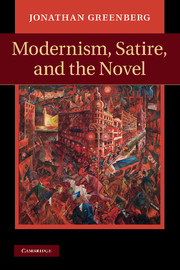Book contents
- Frontmatter
- Contents
- Illustration
- Preface
- Abbreviations
- Chapter 1 Satire and its discontents
- Chapter 2 Modernism's story of feeling
- Chapter 3 The rule of outrage: Evelyn Waugh's Vile Bodies
- Chapter 4 Laughter and fear in A Handful of Dust
- Chapter 5 Cold Comfort Farm and mental life
- Chapter 6 Nathanael West and the mystery of feeling
- Chapter 7 Nightwood and the ends of satire
- Chapter 8 Beckett's authoritarian personalities
- Notes
- Index
Chapter 5 - Cold Comfort Farm and mental life
Published online by Cambridge University Press: 07 October 2011
- Frontmatter
- Contents
- Illustration
- Preface
- Abbreviations
- Chapter 1 Satire and its discontents
- Chapter 2 Modernism's story of feeling
- Chapter 3 The rule of outrage: Evelyn Waugh's Vile Bodies
- Chapter 4 Laughter and fear in A Handful of Dust
- Chapter 5 Cold Comfort Farm and mental life
- Chapter 6 Nathanael West and the mystery of feeling
- Chapter 7 Nightwood and the ends of satire
- Chapter 8 Beckett's authoritarian personalities
- Notes
- Index
Summary
Did Evelyn Waugh actually write the cult classic, Cold Comfort Farm under the female pen-name Stella Gibbons? According to Gibbons's nephew and biographer, Reggie Oliver, such was the conjecture of one contemporary reviewer who was skeptical that a woman journalist could have authored such a witty novel. Although the reviewer's suggestion may today seem both sexist and bizarre, it recognizes, as Faye Hammill observes, “the similarities between Waugh's comic and parodic practice and Gibbons's” even as it misses the feminist force of the novel. Even more significantly, perhaps, it makes explicit the assumption that satire is primarily a male mode of writing. Dubious as this assumption may sound, it is only a correlative of the widely accepted critical view that the sentimental is a female mode – a view endorsed by both boosters of sentimental fiction such as Jane Tompkins, and detractors, such as Ann Douglas. Their debate, although begun as an aesthetic-political argument about nineteenth-century American fiction, clearly has relevance to both the valuation of twentieth-century consumer culture and the agenda of contemporary feminist scholarship. But, despite the differences, both sides share certain assumptions. As Philip Gould has noted, Tompkins's “revisionist critique” of Douglas ends up reproducing “Douglas's gendered premises for understanding nineteenth-century sentimentalism.” Tompkins may reject Douglas's criteria for aesthetic value but she “does not interrogate the category of sentiment so much as revalue it as a feminine possession. [Her] revisionism is founded, in other words, on the same opposition between male and female writers that underlies Douglas's work.”
One way to complicate such a schematic position has been to attend to the suffering male as a site of sentimental cathexis, as in the works of Eve Sedgwick, Julie Ellison, and others – to show, in other words, that the structure of sentimental affect is by no means essentially feminine. But another approach is to attend to the figure of the female satirist, to explore the way in which the very different affective dynamics of satire can structure women's writing as well as men's. While other female satirists of the 1930s might serve to develop this argument – Dorothy Parker or Dawn Powell in the United States, or Ivy Compton-Burnett in England – my case study here will be Cold Comfort Farm. For Gibbons's novel is both sharp enough in its satire that it could be mistaken for Waugh's, and compelling enough in its feminism that it has been claimed for a tradition of female middlebrow writing, and this convergence itself argues against any easy alignment of antisentimental poses with elitism and misogyny – an alignment, it should be clear by now, that seems to me too readily assumed in contemporary criticism. The witty woman, as Regina Barreca notes, has long been regarded as dangerous and subversive of social norms; reading Gibbons can unsettle, I suggest, both the patriarchal prejudices of the 1930s and the critical orthodoxies of literary study today. To get beyond the old oppositions, then, we should attend to the complexity of the ways in which Gibbons positions her protagonist and her novel within discourses of class, and the way that class in the novel moves along multiple axes – wealth, language, education, literacy, manners, and, most crucially here, affect.
- Type
- Chapter
- Information
- Modernism, Satire and the Novel , pp. 92 - 114Publisher: Cambridge University PressPrint publication year: 2011



